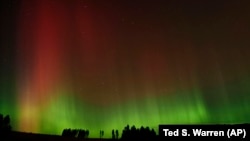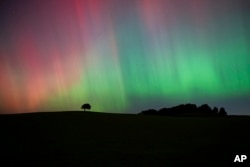Space scientists say unusual lights in the sky, known as the northern lights, are more likely to appear because of intense activity on the sun.
The cause is the 11-year solar cycle. During a period of about 11 years, the sun’s activity changes. The U.S. space agency, NASA, says changes in the sun’s magnetic field cause the activity, which can result in sunspots.
Strong storms on the sun this year have created these “lights” in the sky called auroras. They look like moving waves of color filling the skies similar to what happens as dawn nears. Now, space scientists say these “light shows” are likely to be seen much farther south than usual.
The colors in the sky that people might see may be pink, purple, green or blue. The auroras are called the northern lights because they can usually only be seen in areas in the extreme north of the world near the Arctic Circle.
Space scientists who observe the sun through a special telescope can sometimes see darker places, called sunspots. The sunspots are areas where magnetic fields are stronger than in other places on the sun, NASA says.
The energy released from the interaction of these magnetic fields may cause a flare, a bright spot, which is an explosion of radiation from the sun. It shows up as a flash of light to observers.
Sometimes a large amount of solar material shoots away from the sun. This is called a coronal mass ejection, and it results in a geomagnetic storm when it arrives at the Earth.
The solar cycle at a high point
The sun is currently at the highest part of its 11-year cycle, making solar flares and northern lights more common. NASA and the U.S. National Oceanic and Atmospheric Administration, known as NOAA, say they expect this active period to last for at least another year. But they will not know until months later when solar activity was at its highest.
Kelly Korreck studies the stream of particles that come from the sun called the solar wind. Korreck led a project to develop an instrument to study the solar wind that was on NASA’s Parker Solar Probe that got close to the sun in 2021.
The Parker Solar probe collected material and measured magnetic activity on the sun. Korreck said this solar cycle has provided more colorful auroras farther south and even more are likely. "We still could possibly get some good shows in the next few months," she added.
Solar storms affect Earth
Solar storms are powerful. They can temporarily disrupt electricity service and communications on Earth. NOAA follows space weather and warns operators of power stations and spacecraft in orbit.
In May, NOAA issued a rare severe geomagnetic storm warning. The radiation from the storm that arrived on Earth was the strongest in more than 20 years. It produced northern lights that people could see in many places in the Northern Hemisphere. That same month, scientists recorded the biggest flare erupting from the sun, but Earth was not in its path.
Earlier solar cycles have produced storms more intense than the one in May. Bill Murtagh is the Program Coordinator for the Space Weather Prediction Center at NOAA. He said space weather experts are keeping a close watch on the sun to prepare for any major problems.
Recently, a powerful solar storm gave those watching the sky a beautiful show far from the Arctic Circle. People could see auroras in Germany, Britain, and also in New England and New York City.
I’m Jill Robbins.
Adithi Ramakrishnan reported this story for the Associated Press. Jill Robbins adapted it for Learning English with additional information from NOAA and NASA.
_________________________________________________
Words in This Story
solar - adj. of or relating to the sun
cycle –n. repeated or regular events that happen over a set period of time
dawn –n. when the sun rises above the horizon
disrupt –v. to interfere with normal activities or processes
erupt –v. to explode or shoot out
What do you think of this story? Write to us in the Comments Section.











Forum